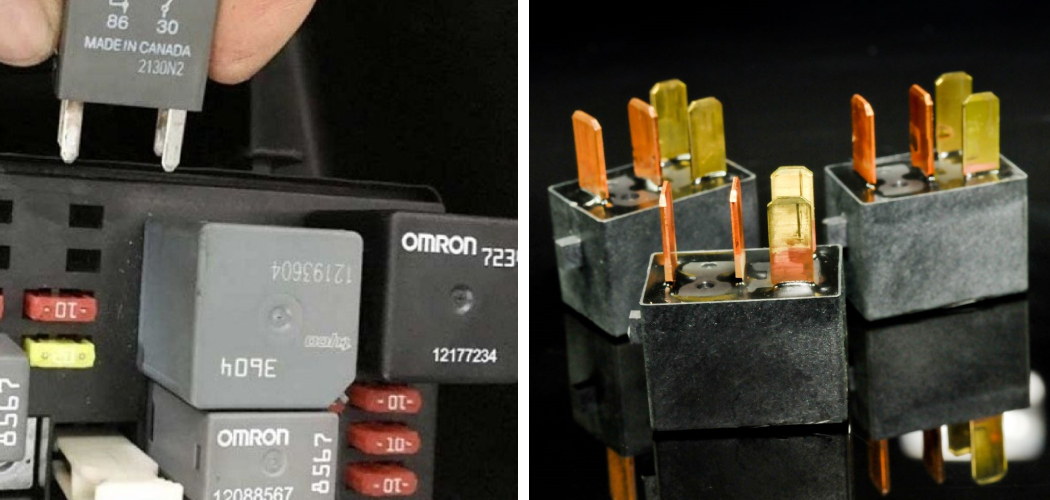The fuel pump relay acts as an electronic switch, providing power to the fuel pump, which in turn ensures the engine receives the fuel necessary for combustion. A faulty relay can disrupt this essential process, leading to significant engine performance issues. Knowing how to tell if your fuel pump relay is bad is crucial for any driver seeking to maintain their vehicle’s reliability.

This article guides you through the telltale symptoms, distinguishing them from similar problems, and offers comprehensive steps for testing and replacement, ensuring you can address the issue with confidence.
Understanding the Fuel System
The fuel system in a modern automobile is composed of several key components, all working in tandem to deliver the right amount of fuel to the engine. The central elements include the fuel tank, fuel lines, fuel pump, fuel filter, and fuel injectors.
Each plays a pivotal role: the fuel tank stores the gasoline or diesel, while the fuel pump, often immersed within the tank itself, pushes fuel through the lines and filter, purifying it before reaching the engine. The fuel injectors then deliver it into the combustion chamber for efficient combustion.
The fuel pump relay is an integral part of this system. Its main function is to act as an intermediary between the fuel pump and the vehicle’s electrical system. When you turn the ignition key, the relay is activated and sends an electrical signal to start the fuel pump, pressuring and moving the fuel from the tank to the engine.
Without a functioning relay, the fuel pump would not receive the necessary power to begin this process, disrupting engine performance. Thus, the partnership between the fuel pump relay and the fuel pump is vital—directly affecting your vehicle’s ability to start and run smoothly.
Symptoms of a Bad Fuel Pump Relay
A fuel pump relay in good condition is critical for a car’s engine to operate efficiently. However, when the relay begins to fail, a number of symptoms can manifest, alerting a driver to the potential issue.
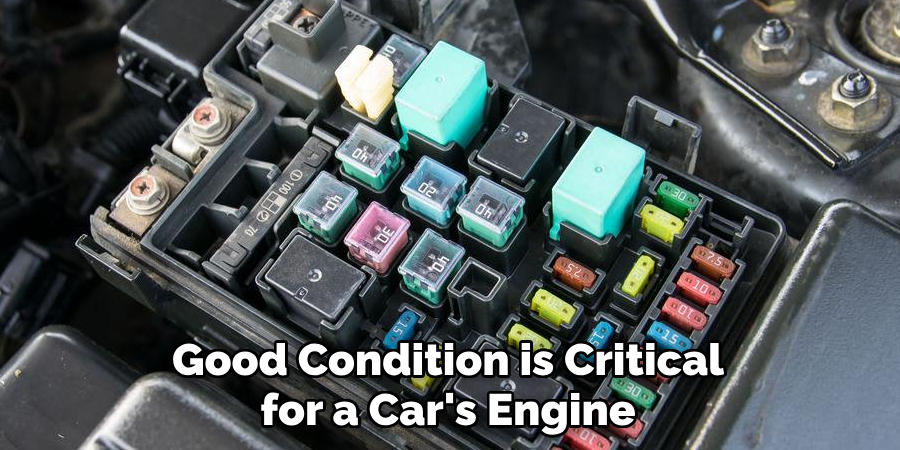
Engine Starting Issues:
- Engine cranks but doesn’t start (most common symptom). The engine cranks but doesn’t start (the most common symptom).
- Intermittent or delayed starting. A failing fuel pump relay can occasionally work, making the car start up after several tries. Delayed starts are often characterized by the engine taking longer than usual to fire up.
- Stalling shortly after starting. If the relay loses power after the engine has already started, it can cause the engine to stall due to a sudden loss of fuel pressure.
- Worsening starting issues in cold weather. Cold weather increases the demand for the battery and can exacerbate starting problems caused by a faulty relay.
Engine Performance Issues:
- Power loss or hesitation during acceleration. A bad fuel pump relay can cause power to the fuel pump to cut out momentarily during acceleration, resulting in a hesitation or a loss of power.
- Jerking or rough idling. Inconsistent relay performance can lead to uneven fuel delivery, causing the engine to jerk or idle roughly.
- Surging or uneven engine RPM. An erratic relay can cause the fuel pump to deliver too much or too little fuel while driving, leading to surging or fluctuations in engine RPM.
Other Potential Symptoms:
- No sound from the fuel pump when turning the key (not present in all vehicles). Some vehicles have an audible hum from the fuel pump when the ignition is turned to the “on” position, indicating its activation. If this sound is absent, it may suggest a relay problem.
- Check engine light illumination (depending on a specific issue). Many vehicles are equipped with diagnostic systems that trigger the check engine light when a fault is detected, including potential issues with the fuel pump relay.
It is essential to recognize that these symptoms are not exclusive to a failing fuel pump relay; they can also indicate other problems within the fuel system or other vehicle components. Diagnosis can be complex and often requires a systematic and technical approach to accurately pinpoint the underlying cause.
Differentiating from Other Problems
Diagnosing a bad fuel pump relay can be perplexing as its symptoms often resemble those of other issues, such as a malfunctioning fuel pump or a faulty ignition system. To isolate the exact cause, it’s important to be observant and recognize additional symptoms that may arise.
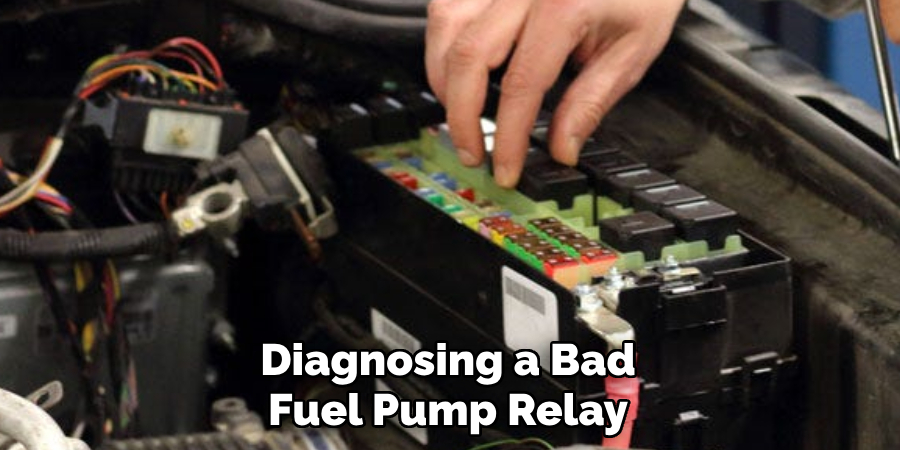
For instance, while both a failing fuel pump and a faulty relay can lead to engine starting problems, a fuel pump generally presents a more consistent pattern of difficulties, whereas relay issues may be more intermittent due to the electrical component’s tendency to fail sporadically. A defective fuel pump often produces a whining noise from the fuel tank area, whereas a bad relay typically does not.
If ignition system issues are suspected, additional symptoms may include misfires and difficulty in starting that persists irrespective of the engine’s temperature. Unlike relay-related problems, which might resolve temporarily, allowing the engine to start, ignition issues usually cause more persistent starting trouble.
Voltage and pressure tests can be conducted to further distinguish between these issues. For the fuel pump relay, a multimeter can confirm whether the proper voltage is reaching the relay terminals, while a fuel pressure gauge can verify that the pump is delivering the correct fuel pressure to the engine. If the relay and voltage are fine but the fuel pressure is inadequate, this points toward a faulty fuel pump.
Professional diagnostic tools, such as an On-Board Diagnostics (OBD) scanner, can be employed for a more definitive diagnosis. These scanners can read error codes from the vehicle’s computer system, helping to pinpoint whether the issue lies with the fuel pump relay or another component.
It is important to remember that while DIY methods can be helpful, professional diagnostic tools can save time and ensure precise identification of the underlying issue, enabling targeted and effective repairs.
Importance of Early Diagnosis and Repair

Neglecting the early signs of a bad fuel pump relay can lead to increasingly severe consequences, potentially culminating in complete engine failure. The erratic fuel supply can cause undue stress on the engine, weakening its components over time.
This heightened strain can result in a catastrophic breakdown, leaving you stranded and in need of roadside assistance. Aside from the inconvenience and potential safety risks of unexpected breakdowns, the cost implications can be substantial.
What starts as a relatively simple and inexpensive repair for a relay can result in costly engine damage if left unaddressed. A well-functioning relay is crucial to maintaining optimal fuel pressure and volume, ensuring smooth engine operations, and preserving the longevity of the fuel pump itself. Therefore, timely diagnosis and repair are imperative to prevent escalation of the issue.
Regular vehicle maintenance, including attention to the fuel system, is the best preventative measure against such failures. Vehicle owners should remain vigilant and responsive to the warning signs, acting promptly upon any symptoms indicative of a malfunction.
In doing so, one safeguards not only the seamless performance of the engine but also upholds the overall value and longevity of the vehicle.
Locating the Fuel Pump Relay
Locating the fuel pump relay in your vehicle is crucial for diagnosis and repair, and the most reliable source of information is your car’s manual. It will provide the exact location of the relay box and assist in identifying the specific relay for the fuel pump. Typically, the relay box is found under the hood or by the steering column.
Once located, relays are often labeled or detailed in a diagram within the cover. If a manual isn’t available, online forums, vehicle repair websites, and sometimes even YouTube tutorials can be invaluable resources, offering walkthroughs and community expertise to assist you in finding the relay.
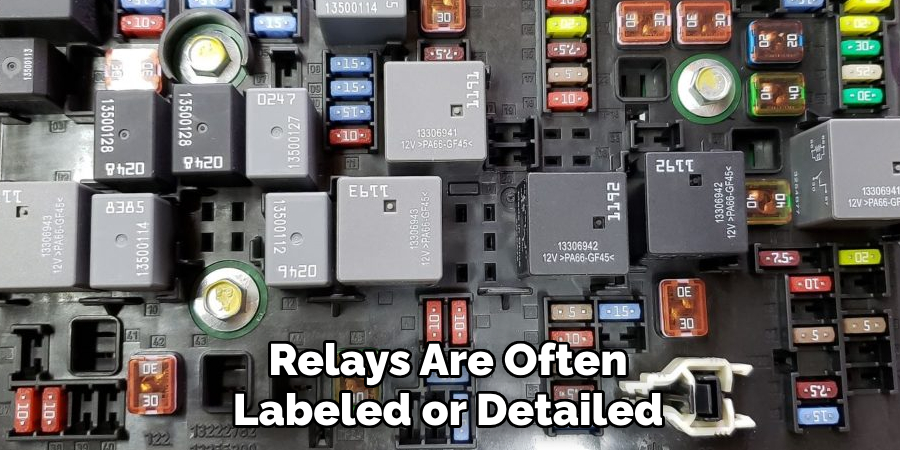
How to Tell if Your Fuel Pump Relay Is Bad: A Beginner’s Guide
Before proceeding with technical diagnostics, a visual inspection of the fuel pump relay can yield valuable clues about its condition. To begin, ensure that the engine is off and the key is removed from the ignition. Locate the fuel pump relay as previously outlined and carefully remove it from its socket.
1. Visual Inspection (basic):
1. Physical Damage: Examine the relay for any signs of physical damage, such as cracks, burn marks, or melting. Such damage often implies that the relay has overheated, which can compromise its functionality.
2. Corrosion: Inspect the relay’s pins for corrosion, which can interfere with electrical conductivity. Corrosion appears as a green or white powdery substance and should be cleaned carefully with an electronic contact cleaner and a fine brush.
3. Loose Connections: Check for looseness in the pins or the socket where the relay plugs in. Loose connections can lead to intermittent power delivery. If necessary, gently bend the pins back to proper alignment for a snug fit.
4. Signs of Wear: Look for other indicators of wear, such as discolored plastic or a worn socket, which could suggest the need for replacement.
2. Multimeter Testing (advanced):
1. Resistance Check: To inspect the resistance of the coil in the relay, set the multimeter to the Ohms (Ω) range. Touch the multimeter probes to the relay terminals that correspond to the coil (consult your vehicle manual for the correct terminals). A functioning relay will typically show a resistance reading between 50 and 120 ohms.
2. Voltage Check: Turn the multimeter to the voltage setting, and with the relay plugged in, have an assistant turn the ignition key to the “on” position. Test for voltage at the relay input terminal by touching one probe to the terminal and the other to a ground point. A reading of approximately 12 volts indicates power correctly reaches the relay.
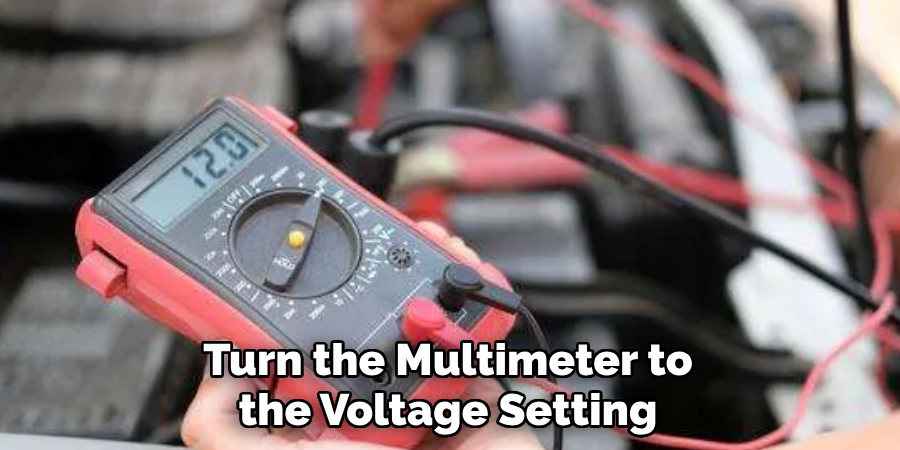
3. Alternative Testing Methods:
Without a multimeter, you can perform a rudimentary test by swapping the fuel pump relay with another identical relay from your vehicle (such as the horn relay). If the problem resolves when swapped, the relay in question is likely defective.
Remember that while visual inspection and multimeter testing can point to a faulty fuel pump relay, these tests are limited to the relay itself. If the relay appears functional, the issue may lie elsewhere in the fuel delivery or electrical system. Depending on the complexity and specs of your vehicle, professional diagnostic equipment may be necessary for a comprehensive assessment.
Replacing the Fuel Pump Relay
Safety is paramount when performing any maintenance on your vehicle’s electrical system. Before beginning the replacement of the fuel pump relay, it is crucial to disconnect the battery.
This helps to prevent any electrical shocks or accidental short circuits. Always wear safety glasses to protect your eyes from sparks or debris. Additionally, it’s advisable to use insulated tools to reduce the risk of electrocution.
To guarantee a successful replacement, make sure to acquire the correct relay for your car’s make and model. This information is typically found in the vehicle’s manual or by consulting with an auto parts specialist.
Safety Precautions:

- Disconnect the negative (-) terminal of the battery. This should be done with the appropriate wrench or plier.
- Wait a few minutes after disconnecting the battery before you begin working on the relay. This is to ensure any residual current has dissipated.
- Wear safety gloves to protect your hands from sharp edges and safety glasses to shield your eyes.
Replacement Steps:
- Find the relay box as previously described using your vehicle manual for guidance.
- Identify and carefully pull out the old fuel pump relay from its socket.
- Inspect the socket for any signs of damage or corrosion. Clean if necessary before proceeding with the installation of the new relay.
- Align the pins of the new relay with the socket and gently press it into place, ensuring a firm and secure fit.
- Reconnect the battery with the positive (+) terminal and the negative (-) terminal.
- Start the engine to verify the successful installation of the new relay.
Assistive diagrams or pictures for these steps should be incorporated here, allowing for clear visual reference and ensuring each step is executed with precision.
In summary, the replacement of a fuel pump relay is a task that many vehicle owners can perform with minimal tools; however, adherence to safety procedures is non-negotiable.
The correct relay part, attention to detail during installation, and post-replacement testing are essential for ensuring the vehicle’s reliability and performance. If any doubt remains about the process or compatibility of components, consider seeking professional assistance.
Seeking Professional Help
Troubleshooting electrical issues in a vehicle can be daunting for beginners, as it involves both understanding the mechanical aspect and ensuring strict safety procedures. If you feel uncertain at any point in the diagnostic or replacement process or encounter difficulties beyond simple fixes, it’s prudent to seek professional help.
An experienced mechanic or a reputable repair shop can provide the expertise needed to accurately diagnose and resolve complex issues. When selecting a professional, consider the following tips:
- Research and Reviews: Look for mechanics or auto repair shops with strong reviews, paying attention to those that mention experiences with your specific type of vehicle or the same issue you’re facing.
- Certifications: Choose professionals who are certified and well-trained. Certifications from reputable automotive organizations can signal a higher level of skill and dedication to quality service.
- Ask Questions: Don’t hesitate to ask detailed questions about their diagnostic methods, the tools they use, and their experience with similar issues. A trustworthy mechanic will be transparent and willing to explain their process.
- Get Multiple Estimates: If possible, get estimates from several mechanics. This can give you a better idea of the expected cost and help identify a reasonable repair price.
- Warranty on Repairs: Inquire about warranties or guarantees on their work. A repair shop that offers a warranty demonstrates confidence in its workmanship and parts.
Remember, while a DIY approach can be rewarding, ensuring the safety and reliability of your vehicle should always be the top priority. Professionals have the advanced tools and expertise to efficiently tackle complex automotive electrical problems, potentially saving you time and avoiding further damage to your vehicle.
Preventative Maintenance for Longevity
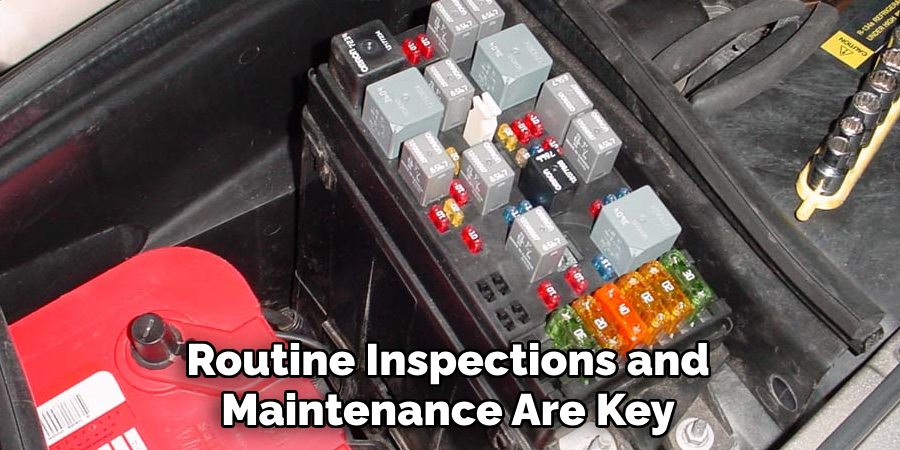
To preemptively ward off issues with your vehicle’s fuel pump relay, routine inspections and maintenance are key. Regularly check your relay for signs of wear or damage; if you’re wondering how to tell if your fuel pump relay is bad, watch out for irregularities in your car’s ignition or a stalling engine, as these can be indicative of potential problems.
Keeping your car’s battery healthy and ensuring clean electrical connections can also extend the life of the relay. Corrosion or loose wiring can cause unnecessary stress on electronic components, including the relay.
It’s good practice to have your vehicle’s entire fuel delivery system – which includes the fuel pump, filter, and relay – inspected by a professional during regular maintenance service intervals to help catch any issues early on.
Conclusion
This guide comprehensively explored how to diagnose, test, and replace a faulty fuel pump relay – a crucial component in your vehicle’s electrical system. As you’ve learned, understanding how to tell if your fuel pump relay is bad and performing routine checks can help avoid disruptions in your vehicle’s performance.
While DIY replacements can be straightforward with the right tools and safety precautions, seeking assistance from a skilled mechanic is advisable for complex issues. Remember, consistent preventative maintenance coupled with prompt attention to any signs of relay failure is the best way to ensure your vehicle remains reliable on the road.

